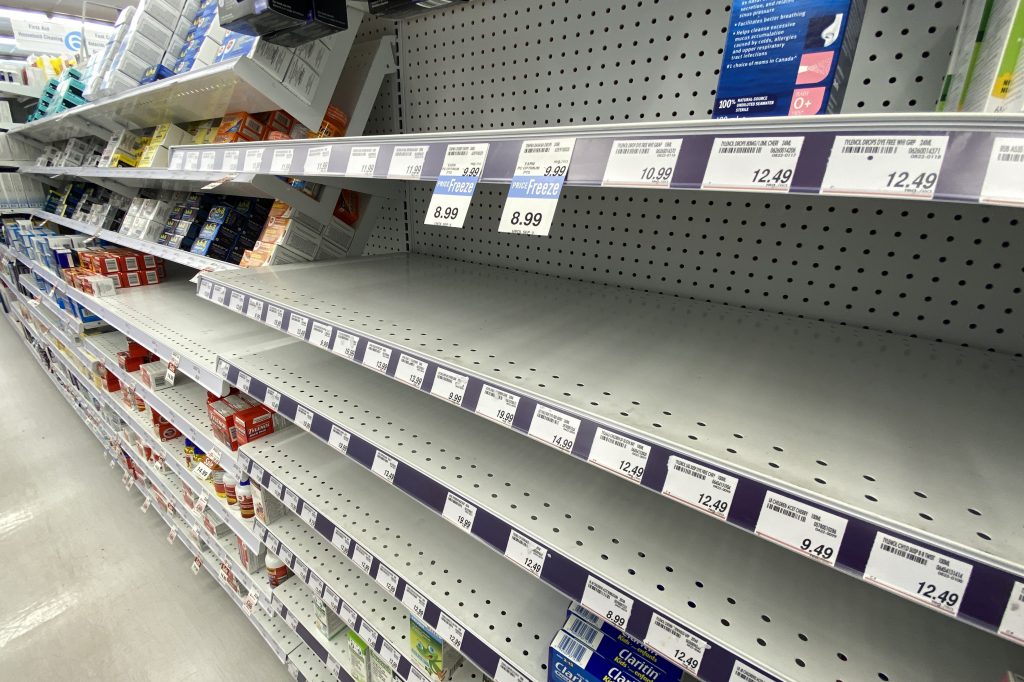No immediate end in sight for shortages of children’s pain medication

Posted October 7, 2022 2:19 pm.
Last Updated October 7, 2022 6:14 pm.
Health Canada says it is working to expand supply and implement shortage mitigation measures when it comes to the shortage of children’s pain medication.
The federal health agency acknowledges there was an unprecedented demand for infant and children’s acetaminophen and ibuprofen products this past summer and supplies have not kept pace.
Health Canada says as production ramps up to “record levels” they are working hand-in-hand with manufacturers and suppliers to ensure that parents and caregivers have access to these products, while also providing pathways to import foreign products, and reaching out to additional suppliers.
Drug companies including Tylenol maker Johnson & Johnson and Advil producer Haleon have already ramped up production to address a “significant spike” in demand ranging from 20 to 40 per cent above historic highs, said a spokesman for the industry group Food, Health & Consumer Products of Canada.
“While supply is increasing, we expect that products will continue to be intermittently available in retail locations,” Health Canada said in an update on Friday. “As we work to get these medicines to all who need it, children’s hospitals remain a particular area of focus for replenishment.”
“As the health of infants and children remains our top priority, all options to solve this shortage are on the table.”
Justin Bates, the CEO of the Ontario Pharmacists Association, says since August they have seen a 300 per cent increase in demand for children’s pain and relief products and while global supply chain issues can be blamed for shortages in other sectors, this is a demand problem and not so much supply.
“This is entirely due to that unprecedented demand because the manufacturers plan over a cycle of four seasons,” he tells CityNews. “When they saw the record levels of the increase in demand, there just wasn’t the capacity to be able to quickly turn around product. That demand issue is not just a Canadian problem, it’s actually global. So even looking at importing products from other jurisdictions, they are having similar challenges.”
RELATED: Parents don’t need prescription to buy children’s cold and flu medicine in Ontario: OPA
Bates points to the lifting of public health measures for a surge in respiratory illnesses that had not been seen in the last two years as one of the primary reasons for the demand, coupled with the fact we are now heading into the fall season and the anticipated spike in fever, colds and COVID symptoms which is making for the “perfect storm” of demand.
When it comes to pain and fever relief, Bates says it is safe to give kids the adult version of Tylenol and Advil provided the dosing is appropriate for the age and weight of the child. He strongly recommends talking with your health care provider when it comes to splitting tablets.
“The other option is that some pharmacists have the active ingredients to compound solutions for the liquid formulation,” he adds. “Not all can do this – and even those are challenging to procure – but there are pharmacists that have that ability.”
The shortage has forced parents to flood social media in their search for any available product. Bates says parents should be mindful of several things when going this route.
“Make sure to check the seal …you want to make sure it hasn’t been tampered with and you want to check the expiration date,” he says.
Bates says he hopes to see empty store shelves replenished with supplies by mid-to-late fall but he warns it could be December before we consistently see fully stocked store shelves.
“I do think many pharmacists will take the product and put it behind the counter to avoid panic buying and to make sure those that need it get it and limit the quantity per purchase.”








